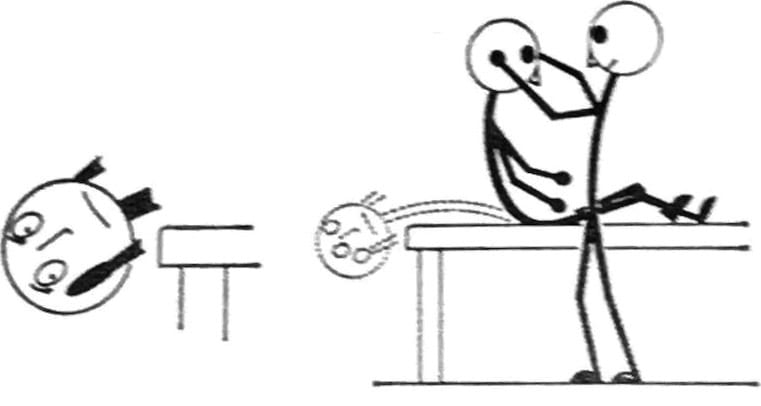Dix-Hallpike Manoeuvre
The Dix-Hallpike manoeuvre is the gold standard test for the diagnosis of posterior semicircular canal benign paroxysmal positional vertigo (BPPV), first described by Dix and Hallpike in 1952. It is used to elicit positional vertigo and characteristic nystagmus associated with BPPV.
- Purpose: Differentiates posterior canal BPPV from other causes of vertigo.
- Mechanism: Displaces otolith debris in the posterior semicircular canal, triggering vertigo and nystagmus due to inappropriate stimulation of vestibular hair cells.

Technique:
- Explain the procedure and reassure the patient. Warn about potential vertigo and nausea.
- Position the patient seated on the examination couch, legs extended.
- Turn the head 45° toward the side being tested.
- Rapidly lower the patient to a supine position with the head extended ~20° below horizontal, hanging off the edge of the bed.
- Observe the eyes for torsional and vertical nystagmus, typically delayed by 2–5 seconds.
- After ~30 seconds or once symptoms resolve, return the patient to sitting.
Positive test: Upbeat-torsional nystagmus and reproduction of vertigo symptoms. Nystagmus usually fatigues with repetition and is transient (<1 minute).
Clinical nuances:
- If the first test is negative but clinical suspicion remains, repeat the test after a short rest. Up to 10–20% of patients with true BPPV may only show positive findings on repeat testing.
- The non-affected side is often tested first to familiarise the patient and mitigate anticipatory anxiety.
- Patients should keep their eyes open, and if available, Frenzel goggles can enhance nystagmus detection.
- Contraindications include severe cervical spine disease, recent neck trauma, or vertebrobasilar insufficiency.
Sensitivity and limitations:
- Reported sensitivity ranges from 48–88% for posterior canal BPPV.
- Visual fixation may suppress nystagmus—watch the patient’s eyes closely and avoid letting them fixate on an object.
Video: Dix-Hallpike in practice
Transcript
- Diagnostic test, used when you suspect benign paroxysmal positional vertigo
- Explain the procedure to the patient, and warn them that they may experience vertigo symptoms during it, but that the symptoms usually subside quickly.
- NOTE: Check that the patient does not have any neck injuries or other contraindications to rapid spinal movements
- NOTE: signs and symptoms usually occur when you turn the patient’s head towards the lesion, so if you suspect disease of the right ear, you may wish to start on their right side – the non-affected side
- Ask the patient to keep their eyes open throughout and stare at your face.
- Have them sit on an examination bed with their legs extended, close enough to the edge so that their head will hang over when they are laid flat.
- Stand on their left side. Take hold of their head with both hands, and turn their head 45° towards you (tests the left posterior canal). Observe their eyes for 30 seconds
- Keeping the patient’s head in the same position, lie them down quickly until their head is hanging over the edge of the couch (still turned 45° towards you). Observe their eyes for 30 seconds.
- Lift the patient back up to sitting position, and repeat the test on their right side
In a patient with BPPV, you will typically see a characteristic pattern of nystagmus emerge after 5-20 seconds, when the patient’s head is hanging towards the side of the lesion. This is torsional or rotatory nystagmus and has two components: a quick movement towards the side of the lesion and a slow component away from it. An upward beating nystagmus is often superimposed on this movement.
History
1952 – Margaret Ruth Dix (1902-1991) and Charles Skinner Hallpike (1900-1979) published a landmark paper in neuro-otology, looking at the three most common peripheral vertigo diseases: Menière’s disease, vestibular neuritis and benign paroxysmal positional vertigo.
They described a clinical bedside manoeuvre in detail, “Lagerungs Manoeuvre”, known now as the Dix-Hallpike test, to provide an immediate diagnosis of BPPV

Associated Persons
- Róbert Bárány (1876-1936)
- Margaret Ruth Dix (1902-1991)
- Charles Skinner Hallpike (1900-1979)
Alternative names
- Lagerungs Manoeuvre
References
Historic references
- Bárány R. Die nervosen Storungen des Cochlear- und Vestibularapparates. In: Handbuch der Neurologie [Lewandowsky M (ed.)] 1910; I(IV): 919-958
- Dix MR, Hallpike CS. The pathology symptomatology and diagnosis of certain common disorders of the vestibular system. Proc R Soc Med. 1952; 45(6): 341-54
- Dix MR, Hallpike CS. The pathology, symptomatology and diagnosis of certain common disorders of the vestibular system. Ann Otol Rhinol Laryngol. 1952; 61(4): 987-1016.
eponymictionary
the names behind the name
Studied at Univerisity of Cambridge - BA MB BChir. British doctor working in emergency medicine in Perth, Australia. Special interests include primary care and emergency medicine.

